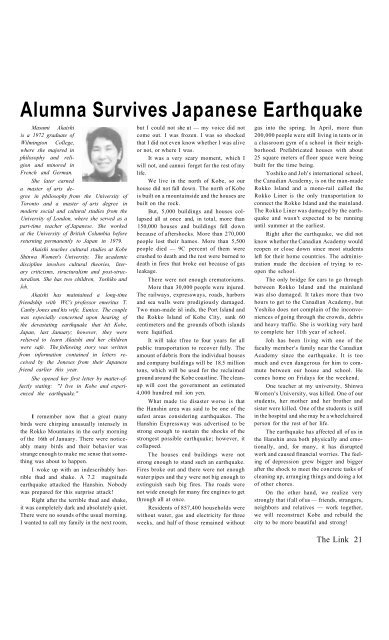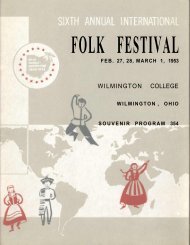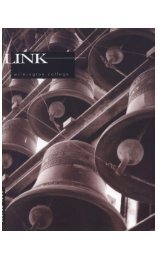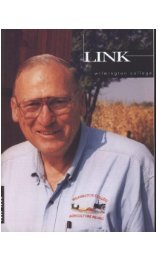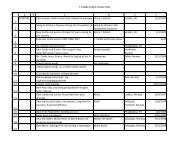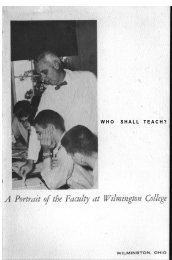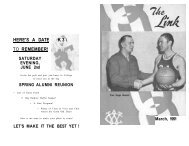Link 1995 10 (Vol. 45, No. 3).pdf - DRC Home - Wilmington College
Link 1995 10 (Vol. 45, No. 3).pdf - DRC Home - Wilmington College
Link 1995 10 (Vol. 45, No. 3).pdf - DRC Home - Wilmington College
Create successful ePaper yourself
Turn your PDF publications into a flip-book with our unique Google optimized e-Paper software.
Alumna Survives Japanese Earthquake<br />
Masumi Akaishi<br />
is a 1972 graduate of<br />
<strong>Wilmington</strong> <strong>College</strong>,<br />
where she majored in<br />
philosophy and religion<br />
and minored in<br />
French and German.<br />
She later earned<br />
a master of arts degree<br />
in philosophy from the University of<br />
Toronto and a master of arts degree in<br />
modern social and cultural studies from the<br />
University of London, where she served as a<br />
part-time teacher of Japanese. She worked<br />
at the University of British Columbia before<br />
returning permanently to Japan in 1979.<br />
Akaishi teaches cultural studies at Kobe<br />
Shinwa Women's University. The academic<br />
discipline involves cultural theories, literary<br />
criticisms, structuralism and post-structuralism.<br />
She has two children, Yoshiko and<br />
Joh.<br />
Akaishi has maintained a long-time<br />
friendship with WC's professor emeritus T.<br />
Canby Jones and his wife, Eunice. The couple<br />
was especially concerned upon hearing of<br />
the devastating earthquake that hit Kobe,<br />
Japan, last January; however, they were<br />
relieved to learn Akaishi and her children<br />
were safe. The following story was written<br />
from information contained in letters received<br />
by the Joneses from their Japanese<br />
friend earlier this year.<br />
She opened her first letter by matter-offactly<br />
stating: "1 live in Kobe and experienced<br />
the earthquake."<br />
I remember now that a great many<br />
birds were chirping unusually intensely in<br />
the Rokko Mountains in the early morning<br />
of the 16th of January. There were noticeably<br />
many birds and their behavior was<br />
strange enough to make me sense that something<br />
was about to happen.<br />
I woke up with an indescribably horrible<br />
thud and shake. A 7.2 magnitude<br />
earthquake attacked the Hanshin. <strong>No</strong>body<br />
was prepared for this surprise attack!<br />
Right after the terrible thud and shake,<br />
it was completely dark and absolutely quiet.<br />
There were no sounds of the usual morning.<br />
I wanted to call my family in the next room,<br />
but I could not she ut — my voice did not<br />
come out. I was frozen. I was so shocked<br />
that I did not even know whether I was alive<br />
or not, or where I was.<br />
It was a very scary moment, which I<br />
will not, and cannoi forget for the rest of my<br />
life.<br />
We live in the north of Kobe, so our<br />
house did not fall down. The north of Kobe<br />
is built on a mountainside and the houses are<br />
built on the rock.<br />
But, 5,000 buildings and houses collapsed<br />
all at once and, in total, more than<br />
150,000 houses and buildings fell down<br />
because of aftershocks. More than 270,000<br />
people lost their hames. More than 5,500<br />
people died — 9C percent of them were<br />
crushed to death and the rest were burned to<br />
death in fires that broke out because of gas<br />
leakage.<br />
There were not enough crematoriums.<br />
More than 30,000 people were injured.<br />
The railways, expressways, roads, harbors<br />
and sea walls were prodigiously damaged.<br />
Two man-made isl inds, the Port Island and<br />
the Rokko Island of Kobe City, sank 60<br />
centimeters and the grounds of both islands<br />
were liquified.<br />
It will take tfree to four years for all<br />
public transportation to recover fully. The<br />
amount of debris from the individual houses<br />
and company buildings will be 18.5 million<br />
tons, which will be used for the reclaimed<br />
ground around the Kobe coastline. The cleanup<br />
will cost the government an estimated<br />
4,000 hundred mil ion yen.<br />
What made tie disaster worse is that<br />
the Hanshin area was said to be one of the<br />
safest areas considering earthquakes. The<br />
Hanshin Expressway was advertised to be<br />
strong enough to sustain the shocks of the<br />
strongest possible earthquake; however, it<br />
collapsed.<br />
The houses end buildings were not<br />
strong enough to stand such an earthquake.<br />
Fires broke out and there were not enough<br />
water pipes and the y were not big enough to<br />
extinguish such big fires. The roads were<br />
not wide enough for many fire engines to get<br />
through all at once.<br />
Residents of 857,400 households were<br />
without water, gas and electricity for three<br />
weeks, and half of those remained without<br />
gas into the spring. In April, more than<br />
200,000 people were still living in tents or in<br />
a classroom gym of a school in their neighborhood.<br />
Prefabricated houses with about<br />
25 square meters of floor space were being<br />
built for the time being.<br />
Yoshiko and Joh's international school,<br />
the Canadian Academy, is on the man-made<br />
Rokko Island and a mono-rail called the<br />
Rokko Liner is the only transportation to<br />
connect the Rokko Island and the mainland.<br />
The Rokko Liner was damaged by the earthquake<br />
and wasn't expected to be running<br />
until summer at the earliest.<br />
Right after the earthquake, we did not<br />
know whether the Canadian Academy would<br />
reopen or close down since most students<br />
left for their home countries. The administration<br />
made the decision of trying to reopen<br />
the school.<br />
The only bridge for cars to go through<br />
between Rokko Island and the mainland<br />
was also damaged. It takes more than two<br />
hours to get to the Canadian Academy, but<br />
Yoshiko does not complain of the inconveniences<br />
of going through the crowds, debris<br />
and heavy traffic. She is working very hard<br />
to complete her 11th year of school.<br />
Joh has been living with one of the<br />
faculty member's family near the Canadian<br />
Academy since the earthquake. It is too<br />
much and even dangerous for him to commute<br />
between our house and school. He<br />
comes home on Fridays for the weekend.<br />
One teacher at my university, Shinwa<br />
Women's University, was killed. One of our<br />
students, her mother and her brother and<br />
sister were killed. One of the students is still<br />
in the hospital and she may be a wheelchaired<br />
person for the rest of her life.<br />
The earthquake has affected all of us in<br />
the Hanshin area both physically and emotionally,<br />
and, for many, it has disrupted<br />
work and caused financial worries. The feeling<br />
of depression grew bigger and bigger<br />
after the shock to meet the concrete tasks of<br />
cleaning up, arranging things and doing a lot<br />
of other chores.<br />
On the other hand, we realize very<br />
strongly that if all of us — friends, strangers,<br />
neighbors and relatives — work together,<br />
we will reconstruct Kobe and rebuild the<br />
city to be more beautiful and strong!<br />
The <strong>Link</strong> 21


